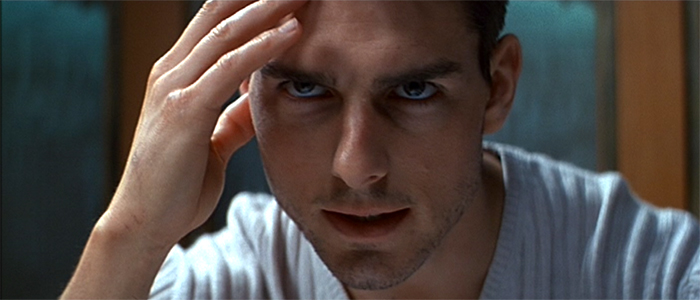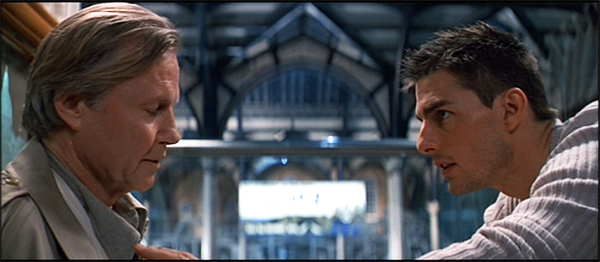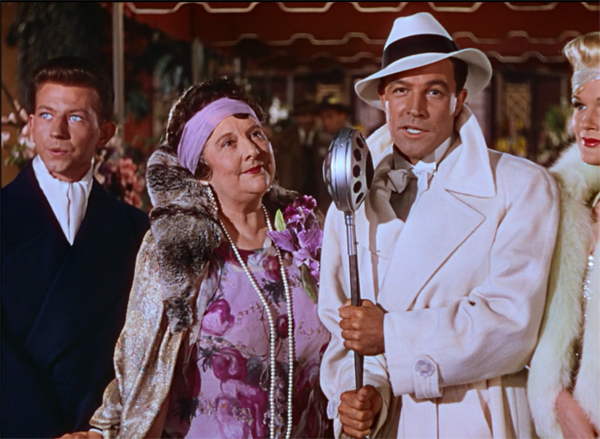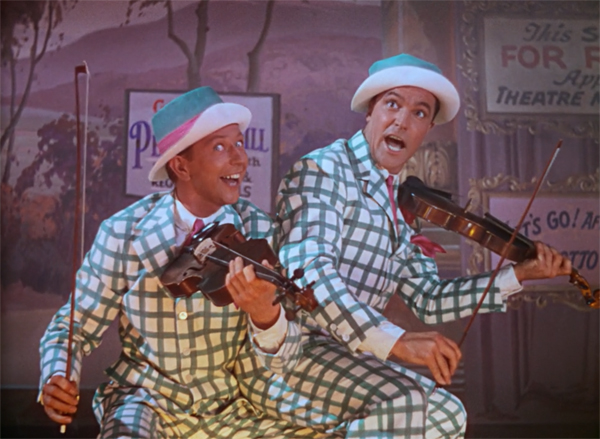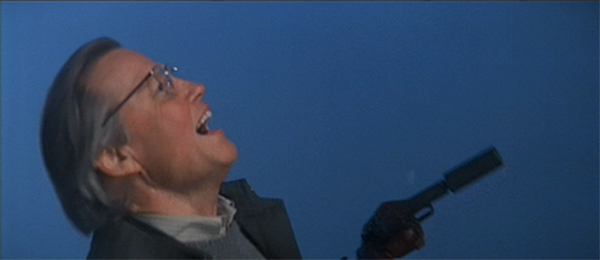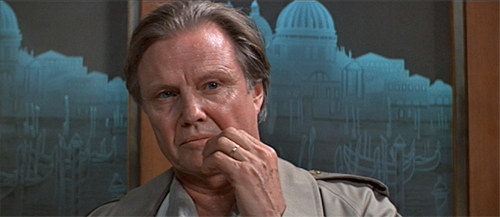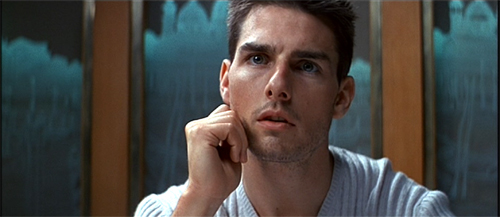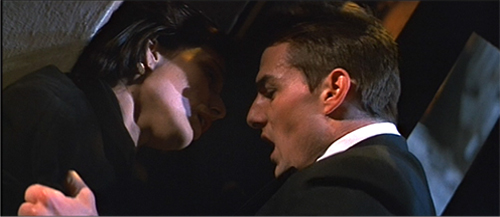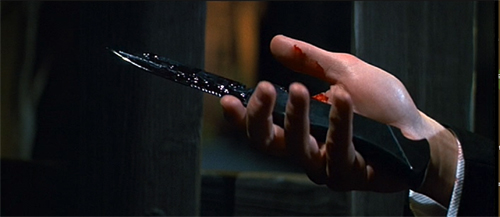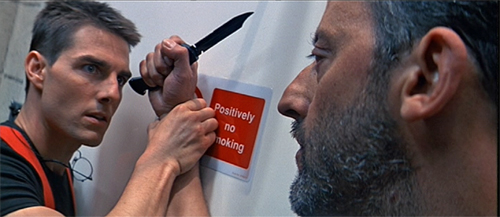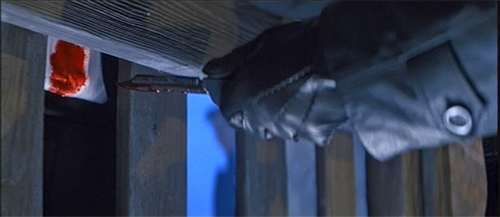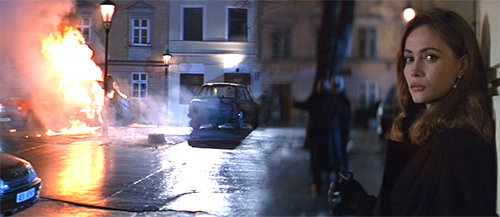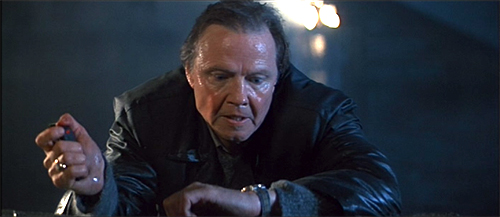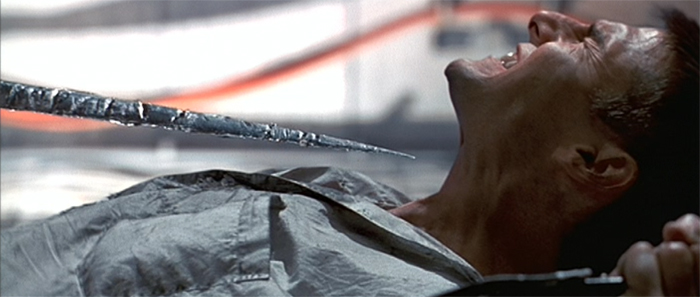Lie to me: MISSION: IMPOSSIBLE
Thursday | June 30, 2022 open printable version
open printable version
Mission: Impossible (1996).
DB here:
Filmmakers rightly consider themselves problem-solvers. They deal with budget limits, scheduling constraints, temperamental staff and casts, and balky equipment. Some problems come with financial demands; others are self-imposed, such as: “Tell a story confined to a single room.” The artistic problems often demand solutions that guide viewers toward clarity, comprehension, and emotional impact.
Suppose your story situation is this. Character A is telling a story, but it’s a lie. Character B realizes it’s a lie, but doesn’t signal that recognition. This is really two problems in one: How do you tell the audience A is lying? And how do you convey that B knows but doesn’t reveal that knowledge?
These are at the crux of in an intriguing sequence in Mission: Impossible. The solutions found by screenwriter David Koepp and director Brian DePalma show how even a straightforward “entertainment movie” can pose interesting questions about cinematic expression.
Spoilers ahead. But I bet you’ve seen this movie.
The problem(s)
The Impossible Mission team has been sent to Prague, purportedly to retrieve a digital disc listing all CIA agents in Europe. They don’t know that this assignment is a pretext for finding a mole, a rogue agent who is selling secrets to foreign interests. While infiltrating a state gala, most of the team is killed. Only Ethan Hunt, point man in the mission, and Claire Phelps, the wife of the team leader Jim Phelps, survive. The IMF chief Kittridge accuses Ethan of being the mole so Ethan, along with Claire, needs to flee. But out of devotion to duty he insists on finding the mole. He learns that the mole under the alias of Job has offered to sell the NOC list to Max, a dealer in covert information. The bulk of the plot revolves around Ethan’s efforts to induce Max to reveal Job, which Ethan can do only by offering Max the NOC list—while at the same time making sure that it doesn’t really fall into Max’s hands.
After a prologue, which I discussed in an earlier entry, the film’s first stretch revolves around the team’s invasion of the embassy party. As the scheme collapses, we see the deaths of the team members. Through cross-cutting and a moving-spotlight narration, the film shows us the technician Jack killed in an elevator shaft, Jim Phelps shot on a bridge and tumbling into the river, Sarah stabbed at a gate, and Hannah killed by a car bomb. The effects of these killings are registered largely through Ethan’s response. He hears Jack lose contact, watches video transmission of Jim’s bloody hands, finds Sarah impaled by a knife, and sees Hannah’s car explode. Later he, and we, will learn that Claire escaped.
At the start of the film’s climax, Ethan discovers that Jim Phelps is still alive. In a café, Jim explains that he survived the shooting and that he saw the killer: Kittridge. Kittridge is the mole, he claims. Jack brings Jim into his plan to meet Max on the Eurostar train and apparently give her the NOC list he’s stolen from Langley.
The twist is that Jim–Ethan’s mentor, friend, and surrogate father–is lying. He is Job the mole, and he has eliminated his own team, faking the attack on himself. Thanks to crosscutting, the first version of the attacks concealed from us the actions Jim takes to kill his colleagues. The narrative problems are: How and when to tell us of Jim’s treachery? And how to represent Ethan’s state of awareness? Is he misled by Jim’s account, or does he doubt it? And what is Claire’s role in all this?
Three solutions
Singin’ in the Rain (1952).
Every creative choice eliminates alternatives, and I’ve compared classical filmmaking to selecting from a menu of more or less favored options. That menu can offer filmmakers ways of solving narrative problems. One choice for the M:I revelation is simply to present Jim telling Ethan his lies in the café. Ethan then can react in horror, leaving us to assume that he doesn’t doubt him.
This option was actually tried out in an early script draft. Jim explains and Ethan, despite some hesitation (“Hold on, it’s taking me a minute to adjust here“), seems to accept his story. Only in their final confrontation on the Eurostar does Ethan reveal that he had long before figured out that Jim had betrayed the team. We had no inkling that in the café Ethan was merely pretending to accept Jim’s account. His awareness of Jim’s scheme was held back as a surprise.
Another narrative option appears in a later script draft. This time Jim’s explanation is accompanied by flashbacks illustrating his lies. He claims to have swum to shore, patched up his gunshot wound, and followed Ethan’s trail. He then tells Ethan it was Kittridge who shot him and killed Sarah, and these moments are illustrated with quick flashback imagery. These are lying flashbacks. As a neat fillip, two of these shots replay Ethan finding Sarah’s body nearby, as if to certify Jim’s story. “Ethan just stares at Phelps, his eyes wide with surprise.” Again, we’re led to think that Ethan trusts Jim’s tale, making the train confrontation a revelation of Ethan’s outplaying Jim.
We should remember that the Hollywood menu provides the lying flashback as an option, albeit rare. In Singin’ in the Rain, for instance, Don Lockwood’s voice-over interview portrays his early career as one of refined show-business accomplishment. “Dignity—always dignity.” But the images undercut this by showing him performing slapstick routines in burlesque. Since this is a comedy, we can understand that the film’s flashbacks are debunking his pretension. As for the second problem, that of conveying a listener’s skepticism, the present-time scenes reinforce the impression of Don’s puffery by showing his pal Cosmo’s eye-rolling reaction. Still, the interviewer and presumably the radio audience are taken in.
This second M:I script variant doesn’t include such hints that Ethan doubts Jim, so the problem of the conveying the listener’s true reaction is bypassed. But the final film supplies yet another solution.
After I drafted what you’ve just read, I heard from screenwriter David Koepp. I had written him to ask about the alterations, and he talked with De Palma about them.
Brian reminded me that the intention of the scene was built around an idea — can we show Jim lying, and simultaneously see Ethan figuring out those lies in his own mind? Without telling Jim that he knows it’s a lie, Ethan is picturing for us what the truth must (or might) have been. It’s a cool idea, and, typical of DePalma, highly visual. Actually seeing on screen versions of events that may or MAY NOT have happened is something we started playing around with in M:I, and then did to a greater degree in Snake Eyes, which we wrote right after that.
Neither one of us can remember in useful detail about why we might have tried several other versions first, but my guess is that the one with Jim simply verbalizing the lie was jettisoned in favor of images for obvious (and again, DePalma-esque) reasons, i.e., it’s better to see something than to hear it. The flashback showing Kittridge as the perpetrator was likely because we wanted to keep going for as long as possible with the character I’ve come to call the Principled Antagonist — POSSIBLY a villain, turns out not to be, but always diametrically opposed to the hero and his goals.
It was good to have my hunch confirmed, and to watch filmmakers sampling the menu of options from draft to draft. The final shooting script presents the new variant. Ethan, not Jim, spells out the scheme in dialogue. This leads Jim to assume that Ethan accepts Kittridge as the culprit. But the image track shows Jim committing the crimes. As the script puts it:
A reprise of PHELPS’s narrative only now ETHAN’S telling it and camera is showing the events as ETHAN sees they actually happened.
There’s still a potential obstacle, though. What if the viewer takes the flashbacks to show what really happened but doesn’t grasp that they’re Ethan’s imaginings? They might be only “the film telling us what really happened,” as in Singin’ in the Rain. How to establish that we’re following Ethan’s train of thought while he lies during his dialogue with Jim?
How to lie to a liar
Here’s the sequence as it appears in the film.
On the first problem, the sequence makes clear that Jim’s accusation of Kittridge is false. We’re introduced to Jim’s treachery with several shots showing Jim engineering Jack’s death in the elevator. Several more shots, stressed through slow-motion, illustrate how Jim faked his own death. And the knifing of Golitsyn and Sarah is attributed to Krieger. You can also argue that wily viewers will take Jim’s sidelong glance at Ethan as a tip-off to his treachery–a classic shot lingering on the Guilty One (as we’ve seen elsewhere).
Still, how can we be sure that Ethan sees “events as they actually happened”–especially since his shock and puzzlement at hearing Jim’s tale seem so genuine?
The sequence solves the second problem with two passages that strongly imply that the flow of images reflects what’s in Ethan’s mind.
First, among phases of the stabbings at the gate, there’s the interpolated shot of Ethan pinning Krieger’s wrist to the wall during the Langley heist.
The two-shot of Ethan and Krieger, a flashback not part of Jim’s story, indicates Ethan’s realization that the knife he found in Sarah’s side was one of Krieger’s. Interestingly, this shot isn’t in the shooting script.
A stronger cue that we’re in Ethan’s mind comes with the “revised and corrected” version of Hannah’s death. Did “backup” take her out? The answer comes with a shot of Claire triggering the explosion and turning to look at the camera.
Claire’s look defies plausibility. It’s as if she is turning to glare, almost defiantly, at the Ethan who’s imagining this. Because he’s attracted to Claire, he wants to give her the benefit of the doubt. His imagination immediately proposes an alternative in which Jim sets off the bomb.
In the train at the climax, Jim will confirm Ethan’s hesitation: he was reluctant to suspect Claire. In the later stretch of the café scene, not included in my extract, the question of her loyalty is evoked as Jim urges Ethan to keep quiet about the scheme. When Ethan returns to Claire at the safe house, there remains the issue of whether her seduction of him is sincere or a further act of betrayal.
More immediately, the two problems are solved. Not only do we have the exposure of Jim’s lie, but we also get glimpses of how Ethan reconstructs what really happened. What makes this all particularly clever is that Ethan’s dialogue seems to confirm Jim’s tale. Ethan’s verbal duplicity is consistent with his talent for bluffing (as with Krieger and the fake NOC disc) and the earlier twinge of suspicion he had about Jim’s Palmer House Bible. When image and sound contradict one another here, we’re obliged to trust the image.
All of which charges Ethan’s final question–“Why, Jim? Why?”–with a double significance. Apparently asking about Kittridge’s motive, Ethan is pressing his mentor, almost desperately. Jim’s answer, about a refusal to accept the end of the Cold War, applies as much to him as to a CIA bureaucrat. We may not fully recognize it at the moment, but Ethan’s question marks the end of their friendship.
Someone might ask if every audience member will realize that the sequence solves both problems. Presumably even a ninny understands that Jim is lying; but maybe some viewers don’t get that Ethan is aware of the lie. My own inclination is to see the cues of Krieger’s knife and the revised version of Hannah’s death as pretty solid hints. Still, we might be in the realm, not unknown to Hollywood cinema, of a film that includes subtleties that not every viewer catches. I’m reminded of a screenwriter’s remark: “It’s not necessary that every viewer understand everything, only that everything can be understood.” This is presumably one reason we return to films and find more in them.
It’s also one reason it’s fun to analyze them.
Thanks to David Koepp and Brian De Palma for responding to my questions. David’s script archive is here.
The remark about understandable stories comes from Ted Elliott, as quoted in Jeff Goldsmith, “The Craft of Writing the Tentpole Movie,” Creative Screenwriting 11, no. 3 (May/ June 2004):, 53.
Mission: Impossible (1996).












